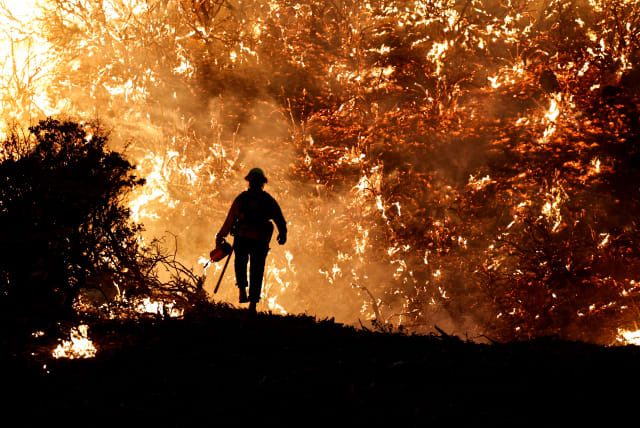Scientists warn of even hotter 2024 as climate crisis intensifies

Prof. Celeste Saulo: "We cannot afford to wait any longer" to reduce greenhouse gas emissions and accelerate the transition to renewable energy sources.
Last year was the warmest on record, according to at least six international datasets consolidated and released by the World Meteorological Organization (WMO) over the weekend.
The data showed that the annual average global temperature was 1.45 ± 0.12 °C above pre-industrial levels (1850-1900) in 2023, with global temperatures setting new records monthly during the second half of the year.
Moreover, according to Dr. Colin Morice, a climate monitoring and research scientist with the Met Office, which produced one of the climate studies, ocean surface temperatures have remained at record levels since April.
"Climate change is the biggest challenge that humanity faces," said WMO Secretary-General Prof. Celeste Saulo in a statement. "It is affecting all of us, especially the most vulnerable."
As explained by Prof. Philip Jones, a professional fellow at the University of East Anglia's Climatic Research Unit, climate change extends beyond merely influencing daily temperatures.
He told The Jerusalem Post that the repercussions of heightened temperatures manifest in various forms, such as intense rainfall leading to floods, wildfires, and droughts. These extreme weather events threaten human lives, agricultural productivity, and the integrity of buildings and infrastructure.
Trends show dramatic rise in temperatures
Last was the 10th year when temperatures exceeded 1.0 °C above the pre-industrial period. Previously, the hottest year was 2016; 2023 was 0.17 °C warmer than that year, according to the Met Office and the University of East Anglia (UEA).
"I've been working with the global temperature series since the early 1980s," Jones said. "There has never been a year like 2023 where the warmest-ever June, warmest-ever July through to the warmest-ever December was recorded for seven months, from June to December 2023."
Scientists attribute the warming to greenhouse gas emissions: carbon dioxide, methane and nitric oxide.
They also explained that 2023 could have been even warmer because the world was transitioning into El Niño conditions, defined by the Met Office and the UEA as "a pattern of climate variability in the tropical Pacific that imparts warmth to the global atmosphere, temporarily adding up to 0.2 °C to the temperature of an individual year. This contrasts the reverse pattern of climate variability, La Niña, which suppressed global average temperatures in 2021 and 2022."
WMO's Saulo warned that "given that El Niño usually has the biggest impact on global temperatures after it peaks, 2024 could be even hotter."
While the differences between the average temperatures in 2016 and 2023 – or even between the pre-industrial era and today – may seem relatively minor, Jones explained that "it is enormous" when put into perspective. He said, for example, that the Ice Age, which peaked about 21,000 years ago, was probably about five degrees colder than today.
Moreover, the WMO pointed out that global temperatures are just one indicator of climate change. The WMO said other indicators are atmospheric greenhouse gas concentrations, ocean heat and acidification, sea level, sea ice extent, and glacier mass balance.
Its State of the Global Climate in 2023 report published in November showed that records were broken on all these fronts.
Researchers say that 2024 is expected to be even hotter. For example, the Met Office and the UEA say average temperatures could reach 1.58 °C above the average for the pre-industrial period next year.
According to Jones, the planet is warming by 0.2 °C on average per decade.
The Met Office and the UEA compile what is known as the HadCRUT5 dataset with support from the National Centre for Atmospheric Science. The WMO uses this and five other international data sets to provide its assessment.
These include data from the United States National Oceanic and Atmospheric Administration (NOAA), NASA's Goddard Institute for Space Studies (NASA GISS), the Berkeley Earth group, the European Centre for Medium-Range Weather Forecasts and its Copernicus Climate Change Service, and the Japan Meteorological Agency (JMA).
"We cannot afford to wait any longer" to reduce greenhouse gas emissions and accelerate the transition to renewable energy sources, Saulo said. "We are already taking action, but we have to do more, and we have to do it quickly."
Jones told The Post that within the next decade, the world will surpass the Paris Agreement goal to limit the temperature increase to 1.5°C above pre-industrial levels. However, he advised that more sustainable actions could reduce the rate at which the world arrives there.
Echoing Saulo, he said: "The sooner we do something, the better."
The Environment and Climate Change portal is produced in cooperation with the Goldman Sonnenfeldt School of Sustainability and Climate Change at Ben-Gurion University of the Negev. The Jerusalem Post maintains all editorial decisions related to the content.
Jerusalem Post Store
`; document.getElementById("linkPremium").innerHTML = cont; var divWithLink = document.getElementById("premium-link"); if (divWithLink !== null && divWithLink !== 'undefined') { divWithLink.style.border = "solid 1px #cb0f3e"; divWithLink.style.textAlign = "center"; divWithLink.style.marginBottom = "15px"; divWithLink.style.marginTop = "15px"; divWithLink.style.width = "100%"; divWithLink.style.backgroundColor = "#122952"; divWithLink.style.color = "#ffffff"; divWithLink.style.lineHeight = "1.5"; } } (function (v, i) { });

